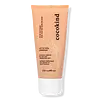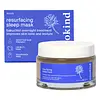What's inside
What's inside
 Key Ingredients
Key Ingredients

 Benefits
Benefits

 Concerns
Concerns

No concerns
 Ingredients Side-by-side
Ingredients Side-by-side

Helianthus Annuus Seed Oil
EmollientGlycerin
HumectantVitis Vinifera Seed Oil
EmollientWater
Skin ConditioningSucrose Laurate
EmollientAvena Sativa Kernel Oil
Skin ConditioningAdansonia Digitata Seed Oil
EmollientSucrose Stearate
EmollientTocopherol
AntioxidantPelargonium Graveolens Flower Oil
MaskingSucrose Palmitate
EmollientAnthemis Nobilis Flower Oil
MaskingAvena Sativa Kernel Extract
AbrasiveLactobacillus Ferment
Skin ConditioningHelianthus Annuus Seed Oil, Glycerin, Vitis Vinifera Seed Oil, Water, Sucrose Laurate, Avena Sativa Kernel Oil, Adansonia Digitata Seed Oil, Sucrose Stearate, Tocopherol, Pelargonium Graveolens Flower Oil, Sucrose Palmitate, Anthemis Nobilis Flower Oil, Avena Sativa Kernel Extract, Lactobacillus Ferment
Water
Skin ConditioningCucumis Sativus Fruit Water
Skin ConditioningGlyceryl Stearates
EmollientGlycerin
HumectantLeuconostoc/Radish Root Ferment Filtrate
AntimicrobialSqualane
EmollientCellulose
AbsorbentBakuchiol
AntimicrobialAdansonia Digitata Seed Oil
EmollientSimmondsia Chinensis Seed Oil
EmollientCaramel
Cosmetic ColorantSodium Dehydroacetate
PreservativeBaptisia Tinctoria Root Extract
Skin ConditioningCitric Acid
BufferingBeta-Glucan
Skin Conditioning
 Reviews
Reviews

Ingredients Explained
These ingredients are found in both products.
Ingredients higher up in an ingredient list are typically present in a larger amount.
Baobab seed oil is an emollient. It is rich in fatty acids and vitamins A, E, and D.
The fatty acid content of this oil is roughly 30-40% oleic acid, 24-34% linoleic acid, and 18-30% palmitic acid. This gives it skin hydrating and nourishing properties.
Due to this fatty acid content, this ingredient may not be fungal-acne safe.
Fun fact: Our skin uses fatty acids, and especially linoleic acid, for creating ceramides.
Learn more about Adansonia Digitata Seed OilGlycerin is already naturally found in your skin. It helps moisturize and protect your skin.
A study from 2016 found glycerin to be more effective as a humectant than AHAs and hyaluronic acid.
As a humectant, it helps the skin stay hydrated by pulling moisture to your skin. The low molecular weight of glycerin allows it to pull moisture into the deeper layers of your skin.
Hydrated skin improves your skin barrier; Your skin barrier helps protect against irritants and bacteria.
Glycerin has also been found to have antimicrobial and antiviral properties. Due to these properties, glycerin is often used in wound and burn treatments.
In cosmetics, glycerin is usually derived from plants such as soybean or palm. However, it can also be sourced from animals, such as tallow or animal fat.
This ingredient is organic, colorless, odorless, and non-toxic.
Glycerin is the name for this ingredient in American English. British English uses Glycerol/Glycerine.
Learn more about GlycerinWater. It's the most common cosmetic ingredient of all. You'll usually see it at the top of ingredient lists, meaning that it makes up the largest part of the product.
So why is it so popular? Water most often acts as a solvent - this means that it helps dissolve other ingredients into the formulation.
You'll also recognize water as that liquid we all need to stay alive. If you see this, drink a glass of water. Stay hydrated!
Learn more about Water